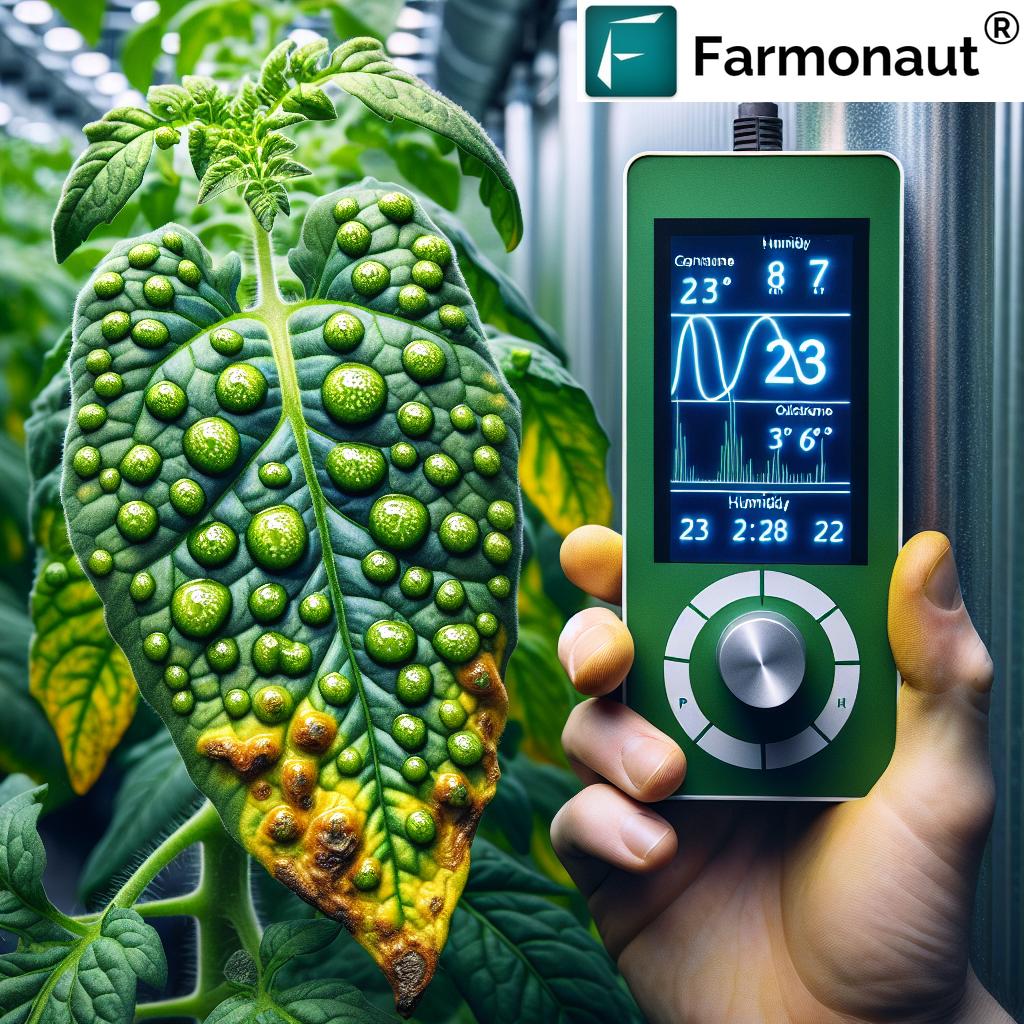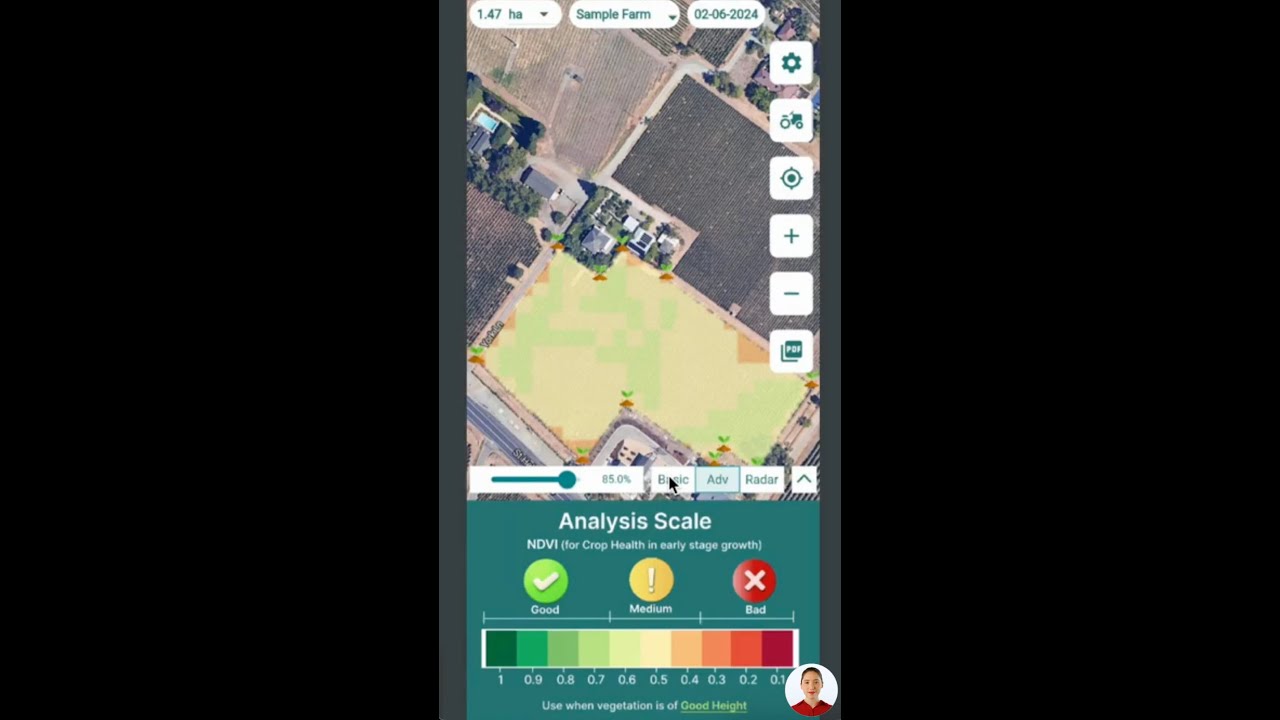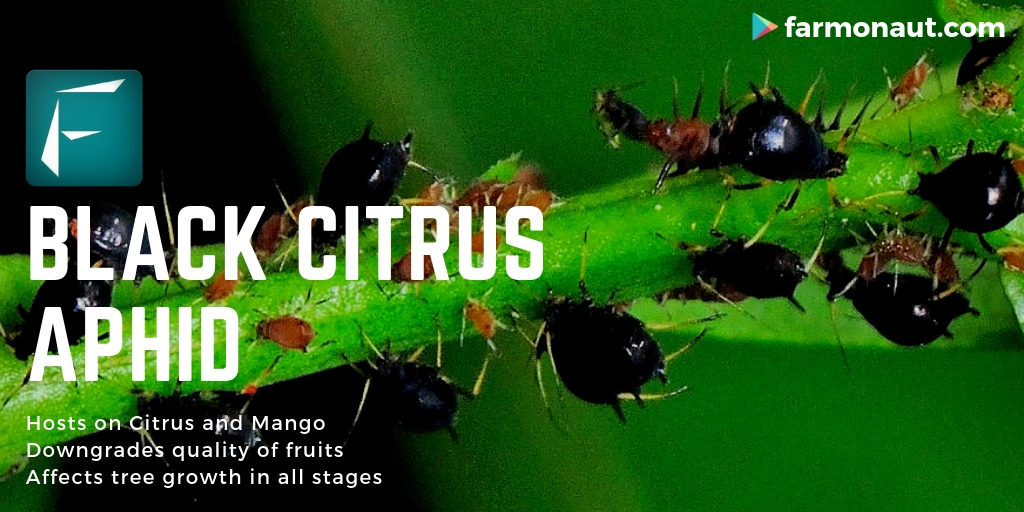Mastering Oedema in Plants: Expert Tips for Effective Greenhouse Climate Control and Crop Protection
“Oedema in plants can cause rapid formation of water-soaked blisters along leaf veins within 24-48 hours.”
Welcome to our comprehensive guide on mastering oedema in plants and optimizing greenhouse climate control. At Farmonaut, we understand the challenges that growers face when dealing with plant physiological disorders, and we’re here to provide you with expert insights and practical solutions. In this blog post, we’ll delve deep into the world of oedema, exploring its symptoms, causes, and most importantly, effective management strategies to protect your crops and boost productivity.
As leaders in agricultural technology, we at Farmonaut are committed to making precision agriculture accessible and affordable for farmers worldwide. Our satellite-based farm management solutions offer real-time crop health monitoring, AI-powered advisory systems, and advanced resource management tools. By integrating these innovative technologies with traditional farming practices, we aim to revolutionize the way you approach plant health and greenhouse management.

Understanding Oedema: A Common Plant Physiological Disorder
Oedema, also known as edema, is a physiological disorder that affects various plant species, particularly those grown in controlled environments like greenhouses. This condition is characterized by the rapid formation of water-soaked blisters along leaf veins, which can significantly impact plant health and crop yield if left unchecked.
Symptoms of Oedema in Plants
- Water-soaked blisters on leaves, particularly along veins
- Yellowing of affected leaves
- Formation of corky or rusty spots as blisters dry out
- Leaf curling or distortion in severe cases
- Reduced plant vigor and growth
Identifying these symptoms early is crucial for effective management. Our Farmonaut platform’s advanced satellite-based crop health monitoring can help you detect anomalies in plant health before they become visible to the naked eye, giving you a head start in combating oedema and other physiological disorders.
The Science Behind Oedema Formation
Oedema occurs when plants absorb water faster than they can transpire it. This excess water accumulates in the plant tissues, causing cells to swell and rupture, forming the characteristic blisters. The primary factors contributing to this condition include:
- High humidity levels in the growing environment
- Fluctuating temperatures, especially when cool nights are followed by warm days
- Poor air circulation around plants
- Overwatering or inconsistent watering practices
- Low light conditions, which can reduce transpiration rates
Understanding these factors is essential for developing effective strategies to prevent and manage oedema in your greenhouse crops.
Mastering Greenhouse Climate Control
“Effective greenhouse climate control can reduce oedema incidence by up to 80% in susceptible plant species.”
Proper greenhouse climate control is the cornerstone of preventing oedema and maintaining optimal plant health. At Farmonaut, we emphasize the importance of creating a balanced environment that promotes healthy plant growth while minimizing the risk of physiological disorders.
Key Factors in Greenhouse Climate Management
- Humidity Control: Maintaining relative humidity levels between 50-70% can significantly reduce the risk of oedema.
- Temperature Regulation: Ensuring consistent temperatures and avoiding drastic fluctuations between day and night.
- Air Circulation: Proper ventilation and air movement help prevent moisture buildup on leaf surfaces.
- Light Management: Providing adequate light levels to promote transpiration and overall plant health.
- Irrigation Practices: Implementing precise watering schedules to avoid overwatering and root saturation.
Our Farmonaut platform offers real-time monitoring and AI-driven insights to help you optimize these factors in your greenhouse environment. By leveraging our technology, you can make data-driven decisions to create the ideal growing conditions for your crops.

Effective Strategies for Oedema Management
Managing oedema requires a multi-faceted approach that combines preventive measures with targeted interventions. Here are some expert tips to help you combat this plant physiological disorder:
1. Humidity Management
Controlling humidity is crucial in preventing oedema. We recommend:
- Using dehumidifiers or ventilation systems to maintain optimal humidity levels
- Increasing air circulation with fans to reduce moisture on leaf surfaces
- Avoiding overhead watering, especially in the evening
2. Temperature Control
Stable temperatures are key to reducing oedema risk:
- Maintain consistent day and night temperatures
- Use heating systems to prevent rapid temperature drops at night
- Implement shade curtains to prevent excessive heat buildup during peak sunlight hours
3. Watering Techniques
Proper watering practices can significantly reduce oedema incidence:
- Water plants in the morning to allow excess moisture to evaporate during the day
- Use drip irrigation or bottom watering methods to keep foliage dry
- Monitor soil moisture levels and adjust watering frequency accordingly
4. Nutrient Management
Balanced nutrition plays a role in plant resilience:
- Ensure proper calcium levels, as calcium deficiency can increase susceptibility to oedema
- Avoid excessive nitrogen fertilization, which can promote lush, susceptible growth
- Use foliar sprays with calcium and silicon to strengthen cell walls
5. Plant Selection and Spacing
Choose and arrange plants wisely:
- Select varieties known for their resistance to oedema
- Space plants adequately to promote air circulation
- Consider using vertical growing systems to improve air flow
By implementing these strategies and leveraging Farmonaut’s advanced crop monitoring technology, you can significantly reduce the incidence of oedema in your greenhouse crops.
Integrated Pest Management (IPM) and Oedema Control
While oedema is not caused by pests or pathogens, implementing an integrated pest management (IPM) approach can complement your efforts in controlling this physiological disorder. IPM strategies focus on preventive measures and sustainable practices that promote overall plant health, making crops more resilient to various stresses, including oedema.
Key Components of IPM for Oedema Management:
- Cultural Controls: Implementing proper sanitation, crop rotation, and plant spacing to create an environment less conducive to oedema development.
- Biological Controls: Introducing beneficial microorganisms that can enhance plant resilience and improve nutrient uptake.
- Mechanical Controls: Using physical barriers or traps to manage pests that may indirectly stress plants and increase susceptibility to oedema.
- Chemical Controls: As a last resort, using targeted, environmentally-friendly treatments to address severe pest or disease issues that may exacerbate oedema.
At Farmonaut, we advocate for a holistic approach to plant health. Our AI-powered advisory system, Jeevn AI, can provide personalized recommendations for implementing IPM strategies tailored to your specific crop and growing conditions.
Organic Crop Protection Strategies for Oedema Management
For growers committed to organic farming practices, there are several effective strategies to manage oedema without relying on synthetic chemicals:
- Compost Tea Applications: Foliar sprays of compost tea can strengthen plant immune systems and improve overall health.
- Silica Supplementation: Organic silica sources can help strengthen cell walls, making plants more resistant to oedema.
- Beneficial Microorganisms: Introducing mycorrhizal fungi and beneficial bacteria can enhance nutrient uptake and stress resistance.
- Plant-Based Sprays: Neem oil and other botanical extracts can act as natural fungicides and plant strengtheners.
- Crop Rotation: Implementing a diverse crop rotation can break pest and disease cycles while improving soil health.
These organic methods not only help in managing oedema but also contribute to sustainable agriculture practices, aligning with Farmonaut’s mission to promote environmentally friendly farming techniques.
Advanced Crop Protection Technology for Oedema Prevention
At Farmonaut, we’re at the forefront of crop protection technology, offering innovative solutions to help you stay ahead of plant physiological disorders like oedema. Our advanced tools include:
- Satellite-Based Crop Health Monitoring: Real-time vegetation health indices (NDVI) to detect early signs of plant stress.
- AI-Powered Advisory System: Personalized recommendations based on crop data, weather patterns, and historical trends.
- Precision Agriculture Tools: Resource management features to optimize irrigation and fertilization practices.
- Weather Forecasting Integration: Accurate predictions to help you prepare for conditions that may trigger oedema.
By leveraging these technologies, you can take a proactive approach to oedema prevention and overall crop health management.
Managing Plant Humidity and Water Stress
Effective management of plant humidity and water stress is crucial in preventing oedema and maintaining optimal plant health. Here are some key strategies:
1. Precision Irrigation
- Use soil moisture sensors to monitor water levels accurately
- Implement drip irrigation systems for targeted water delivery
- Adjust watering schedules based on plant growth stages and environmental conditions
2. Humidity Control Measures
- Install hygrometers to monitor relative humidity levels
- Use automated ventilation systems to maintain optimal humidity
- Consider using humidity-absorbing materials in high-risk areas
3. Plant Spacing and Pruning
- Ensure adequate spacing between plants to improve air circulation
- Regularly prune dense foliage to reduce humidity traps
- Remove lower leaves to improve air movement around the plant base
4. Substrate Management
- Choose well-draining growing media to prevent water logging
- Incorporate materials like perlite or vermiculite to improve aeration
- Regularly monitor substrate pH and EC levels to ensure optimal nutrient uptake
By implementing these strategies and utilizing Farmonaut’s advanced monitoring tools, you can create an environment that minimizes water stress and reduces the risk of oedema development in your crops.
Sustainable Agriculture Practices for Long-Term Oedema Management
At Farmonaut, we believe that sustainable agriculture practices are key to long-term success in managing plant physiological disorders like oedema. By adopting these practices, you not only reduce the risk of oedema but also contribute to a more resilient and environmentally friendly farming system:
- Crop Diversification: Planting a variety of crops can help break pest and disease cycles, reducing overall plant stress.
- Soil Health Management: Implementing cover cropping, composting, and minimal tillage practices to improve soil structure and microbial activity.
- Water Conservation: Using rainwater harvesting and efficient irrigation systems to reduce water waste and maintain consistent soil moisture levels.
- Integrated Nutrient Management: Combining organic and inorganic fertilizers to provide balanced nutrition and enhance plant resistance to stress.
- Biodiversity Promotion: Creating habitat for beneficial insects and microorganisms that contribute to overall ecosystem health.
Our platform’s advanced analytics and AI-driven insights can help you implement and optimize these sustainable practices, ensuring long-term success in managing oedema and other plant health challenges.
Plant Health Monitoring: The Key to Oedema Prevention
Effective plant health monitoring is crucial for early detection and prevention of oedema. At Farmonaut, we provide cutting-edge tools to help you stay ahead of potential issues:
- Real-Time Satellite Imagery: Our platform provides up-to-date multispectral images of your crops, allowing you to spot anomalies before they become visible to the naked eye.
- Vegetation Health Indices: We offer advanced metrics like NDVI (Normalized Difference Vegetation Index) to assess plant vigor and stress levels accurately.
- Historical Data Analysis: By comparing current crop conditions with historical data, you can identify trends and predict potential oedema outbreaks.
- AI-Powered Alerts: Our system can send you notifications when conditions favorable for oedema development are detected, allowing for timely interventions.
By leveraging these advanced monitoring capabilities, you can take a proactive approach to oedema management, ensuring healthier crops and higher yields.
Oedema Management Strategies Comparison
| Management Strategy | Effectiveness | Implementation Difficulty | Cost |
|---|---|---|---|
| Humidity Control | High | Moderate | Medium |
| Temperature Regulation | High | Moderate | Medium |
| Improved Air Circulation | Medium | Easy | Low |
| Proper Watering Techniques | High | Easy | Low |
| Use of Resistant Plant Varieties | Medium | Easy | Medium |
Conclusion: Mastering Oedema Management with Farmonaut
As we’ve explored throughout this comprehensive guide, managing oedema in plants requires a multifaceted approach that combines careful environmental control, advanced monitoring techniques, and sustainable agricultural practices. By implementing the strategies we’ve discussed and leveraging Farmonaut’s cutting-edge technology, you can significantly reduce the risk of oedema and other physiological disorders in your greenhouse crops.
Remember, effective oedema management is not just about treating symptoms but creating an optimal growing environment that promotes overall plant health and resilience. With Farmonaut’s satellite-based crop monitoring, AI-powered advisory system, and precision agriculture tools, you have the resources needed to take your greenhouse management to the next level.
We invite you to explore our range of solutions and see how Farmonaut can help you achieve healthier crops, higher yields, and more sustainable farming practices. Together, we can revolutionize the way you approach plant health and greenhouse management.
FAQs
- Q: What is the primary cause of oedema in plants?
A: Oedema primarily occurs when plants absorb water faster than they can transpire it, leading to cell rupture and blister formation. - Q: How can I differentiate oedema from other plant diseases?
A: Oedema is characterized by water-soaked blisters along leaf veins that eventually turn corky, unlike fungal or bacterial infections which often show different patterns. - Q: Are some plants more susceptible to oedema than others?
A: Yes, certain plants like geraniums, ivy, and some succulents are more prone to oedema, especially when grown in greenhouse conditions. - Q: Can oedema spread from one plant to another?
A: No, oedema is a physiological disorder and not contagious. However, plants grown under similar conditions may all develop oedema. - Q: How quickly can Farmonaut’s satellite monitoring detect potential oedema issues?
A: Our system can detect early signs of plant stress that may lead to oedema within days, allowing for rapid intervention.
Ready to take your greenhouse management to the next level? Explore Farmonaut’s innovative solutions today!
Web App | API | API Developer Docs



















